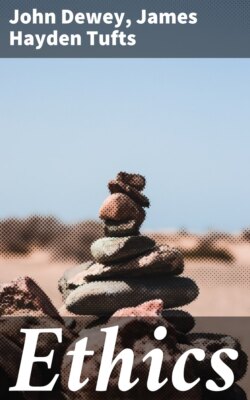Читать книгу Ethics - Джон Дьюи - Страница 14
§ 2. KINSHIP AND HOUSEHOLD GROUPS
Оглавление1. The Kinship Group.—The kinship group is a body of persons who conceive of themselves as sprung from one ancestor, and hence as having in their veins one blood. It does not matter for our study whether each group has actually sprung from a single ancestor. It is highly probable that the contingencies of food-supply or of war may have been an original cause for the constitution of the group, wholly or in part. But this is of no consequence for our purpose. The important point is that the members of the group regard themselves as of one stock. In some cases the ancestor is believed to have been an animal. Then we have the so-called totem group, which is found among North American Indians, Africans, and Australians, and was perhaps the early form of Semitic groups. In other cases, some hero or even some god is named as the ancestor. In any case the essential part of the theory remains the same: namely, that one blood circulates in all the members, and hence that the life of each is a part of the common life of the group. There are then no degrees of kindred. This group, it should be noted, is not the same as the family, for in the family, as a rule, husband and wife are of different kinship groups, and continue their several kinship relations. Among some peoples marriage ceremonies, indeed, symbolize the admission of the wife into the husband's kinship, and in this case the family becomes a kinship group, but this is by no means universally the case.
The feeling that one is first and foremost a member of a group, rather than an individual, is furthered among certain kin groups by a scheme of class relationship. According to this system, instead of having one definite person whom I, and I alone, regard and address as father or mother, grandfather, uncle, brother, sister, I call any one of a given group or class of persons mother, grandfather, brother, sister. And any one else who is in the same class with me calls the same persons, mother, grandfather, brother, or sister.[7] The simplest form of such a class system is that found among the Hawaiians. Here there are five classes based upon the generations corresponding to what we call grandparents, parents, brothers and sisters, children, and grandchildren, but the words used to designate them do not imply any such specific parentage as do these words with us. Bearing this in mind, we may say that every one in the first class is equally grandparent to every one in the third; every one in the third is equally brother or sister to every other in the third, equally father or mother to every one in the fourth, and so on. In Australia the classes are more numerous and the relationships far more intricate and complicated, but this does not, as might be supposed, render the bond relatively unimportant; on the contrary, his relationship to every other class is "one of the most important points with which each individual must be acquainted"; it determines marital relations, food distribution, salutations, and general conduct to an extraordinary degree. A kinship group was known as "tribe" or "family" (English translation) among the Israelites; as genos, phratria, and phyle among the Greeks, gens and curia among the Romans; clan in Scotland; sept in Ireland; Sippe in Germany.
2. The Family or Household Group.—Two kinds of families may be noted as significant for our purpose. In the maternal family the woman remains among her own kin, and the children are naturally reckoned as belonging to the mother's kin. The husband and father is more or less a guest or outsider. In a blood feud he would have to side with his own clan and against that of his wife if his clan quarreled with hers. Clan and family are thus seen to be distinct. In the paternal, which easily becomes the patriarchal family the wife leaves her relatives to live in her husband's house and among his kin. She might then, as at Rome, abjure her own kindred and be formally adopted into her husband's gens or clan. The Greek myth of Orestes is an illustration of the clashing of these two conceptions of father kin and mother kin, and Hamlet's sparing of his mother under similar circumstances, shows a more modern point of view.
It is evident that with the prevalence of the paternal type of family, clan and household ties will mutually strengthen each other. This will make an important difference in the father's relation to the children, and gives a much firmer basis for ancestral religion. But in many respects the environing atmosphere, the pressure and support, the group sympathy and group tradition, are essentially similar. The important thing is that every person is a member of a kindred, and likewise, of some family group, and that he thinks, feels, and acts accordingly.[8]
